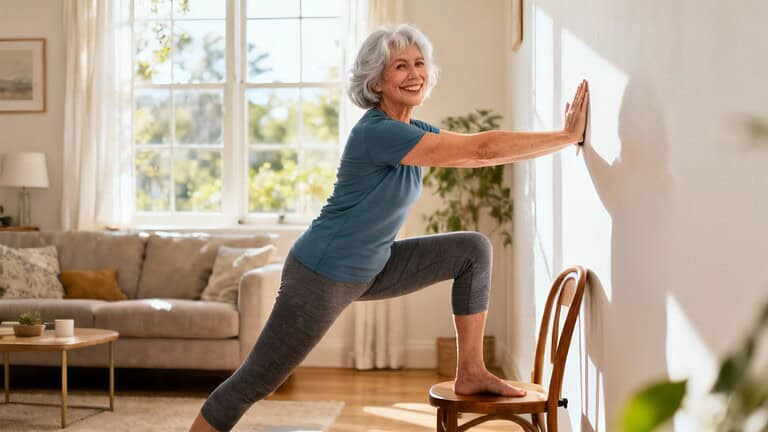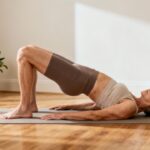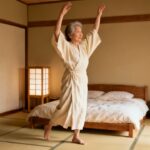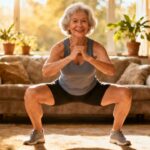Are your legs starting to feel weaker than they used to? If you’re over 50, you’re definitely not alone. Many people notice that their legs don’t feel as strong or stable as they once did.
Maybe climbing stairs now leaves you a little winded, or perhaps your knees begin to ache after just a short walk.
Here’s the good news: you don’t need a gym, expensive equipment, or hours of intense workouts to transform your lower body.
In this article, I’m going to share six simple isometric exercises that can truly change your legs. These movements will help you build strength, improve mobility, and move with more confidence.
Why Isometric Exercises Are Perfect After 50
After 50, our muscles naturally lose about 3 to 5% of their mass with each decade, especially in the lower body. This explains why simple tasks such as standing up from a chair or walking uphill can feel increasingly challenging.
Additionally, your joints lose some of their natural cushioning, which makes high-impact exercises like running or jumping riskier than they used to be.
This is where isometric exercises come in. They involve holding a position that engages your muscles without moving your joints. This method builds strength and stability while remaining gentle on the body.
A study published in the Journal of Strength and Conditioning Research found that isometric training can increase muscle strength by up to 20% in just 6 weeks, even for older adults.
6 Simple Exercises to Transform Your Legs
1. Wall-Supported Chair Hold
This powerhouse move strengthens your quads, glutes, and core without putting unnecessary stress on your knees.
Stand with your back flat against a wall with your feet positioned about 18 inches away from it. Slowly slide down the wall until your thighs are as close to parallel with the floor as feels comfortable.
Hold this position for 20 to 30 seconds, breathing steadily and keeping your core engaged.Rest for 30 seconds, then repeat three times.
When I first tried this move, I could barely hold it for 15 seconds without my legs shaking. But after just a week, I noticed I could stand up from my couch much more easily and without needing to use my hands.
2. Standing Calf Hold
This exercise targets your calves, often the unsung heroes of balance and walking. Stand facing a wall with your feet hip-width apart. Place your hands lightly on the wall for balance. Rise up onto the balls of your feet, lifting your heels as high as you comfortably can.
Hold this position for 20 to 30 seconds, keeping your legs straight but not locked. Slowly lower your heels back to the floor. Rest for 30 seconds, then repeat three times.
A study from the American College of Sports Medicine showed that strengthening your calves can improve walking efficiency by 15% in older adults.
3. Isometric Glute Bridge Hold
This fantastic exercise strengthens your glutes and hamstrings while also supporting your lower back.
Lie on your back on a comfortable surface. Bend your knees and place your feet flat on the floor hip-width apart. Tighten your core and lift your hips until your body forms a straight line from your shoulders to your knees.
Hold this position for 20 to 30 seconds, squeezing your glutes and keeping your core engaged.
Research published in the Journal of Physical Therapy Science shows that glute strengthening exercises like this one can reduce lower back pain by up to 25% in older adults.
4. Side Leg Hold
This exercise targets your outer hips and thighs, key muscle groups that help keep you steady and mobile.
Stand next to a wall or sturdy chair for support with your feet hip-width apart. Lift your right leg out to the side as high as feels comfortable.
Hold your leg in this raised position for 15 to 20 seconds, focusing on the tension in your outer hip and thigh.
Slowly lower your leg back down with control. Rest for 30 seconds, then repeat three times per side.
A study published in the Journal of Geriatric Physical Therapy found that hip strengthening exercises like this can improve balance by 20% in seniors.
5. Isometric Hamstring Curl Hold
This move is fantastic for strengthening the back of your thighs, muscles that are essential for walking, climbing stairs, and maintaining good balance.
Stand behind a sturdy chair or near a wall for balance with your feet hip-width apart. Bend your right knee, lifting your heel toward your glutes as if you were doing a hamstring curl.
Pause and hold the movement when your thigh is parallel to the ground. Hold this position for 15 to 20 seconds, feeling the tension in your hamstring.
Research published in the Journal of Sports Science shows that strengthening your hamstrings can improve knee stability and reduce injury risk by up to 30% in older adults.
6. Isometric Squat Hold
This move is a true powerhouse for your entire lower body, targeting your quads, glutes, hamstrings, and even your core.
Stand with your feet shoulder-width apart with your toes pointing slightly outward. Lower your body as if you’re sitting back into a chair, keeping your knees directly over your ankles and your back nice and straight.
Stop when your thighs are as close to parallel with the ground as feels comfortable for you, and hold that position for 20 to 30 seconds.
A study published in the European Journal of Applied Physiology found that isometric squats can boost lower body strength by 15% in older adults after just four weeks of practice.
Putting It All Together
To make these exercises a habit, I recommend doing them as a circuit. Go through each exercise once, then rest for 1 minute.
Repeat the circuit two more times. Personally, I like to complete this routine in the morning while my coffee brews. It’s become as natural a part of my day as brushing my teeth.
Consistency is absolutely the key to seeing results. Aim to practice these exercises four to five days a week. If you feel a little sore at first, that’s a good sign.
It means your muscles are responding and getting stronger. Just be sure to listen to your body and avoid pushing through any sharp pain.
Nutrition Tips for Better Results
For an extra boost, be mindful of your nutrition as well. Protein is especially crucial after 50 to support muscle recovery. Try to include eggs, chicken, fish, or beans with every meal.
A study from the Journal of Nutrition found that older adults who consume enough protein maintain 40% more muscle mass over time compared to those who don’t.
Also, be sure to stay hydrated by drinking eight glasses of water a day. This helps keep your energy levels up and prevents muscle cramps. These small changes can greatly amplify the benefits of your workout routine.
Start Your Transformation Today
If you’re ready to start feeling stronger and moving better, begin today with just one set of each exercise. Your legs will thank you the next time you’re climbing stairs, gardening, or dancing with ease.
These six simple exercises, done consistently, can help you build the strength and confidence you need to enjoy an active, vibrant life after 50.








